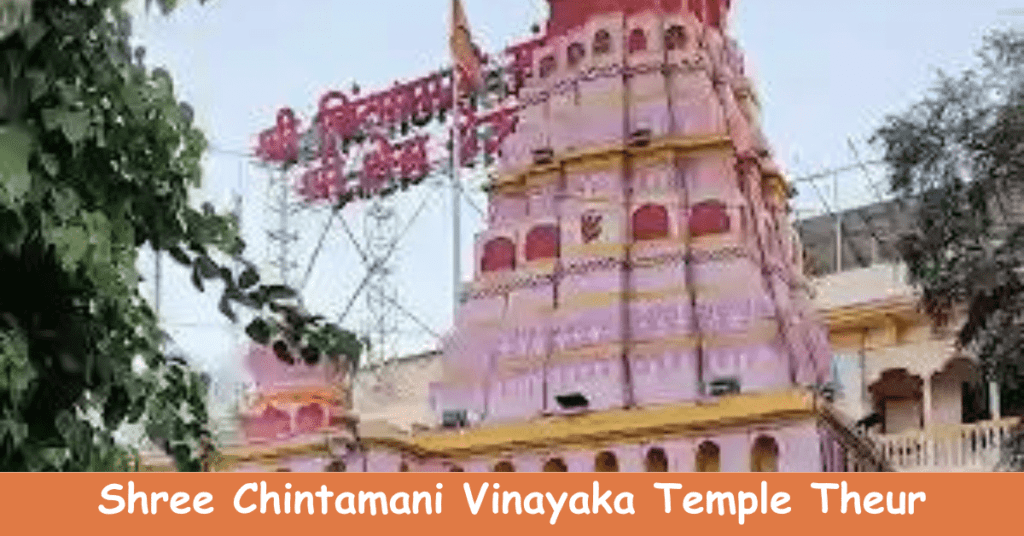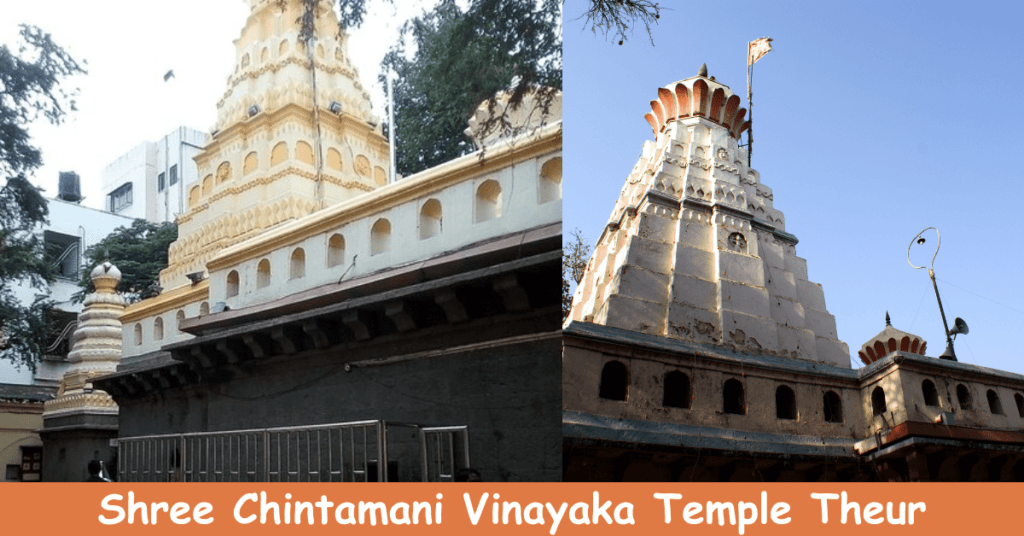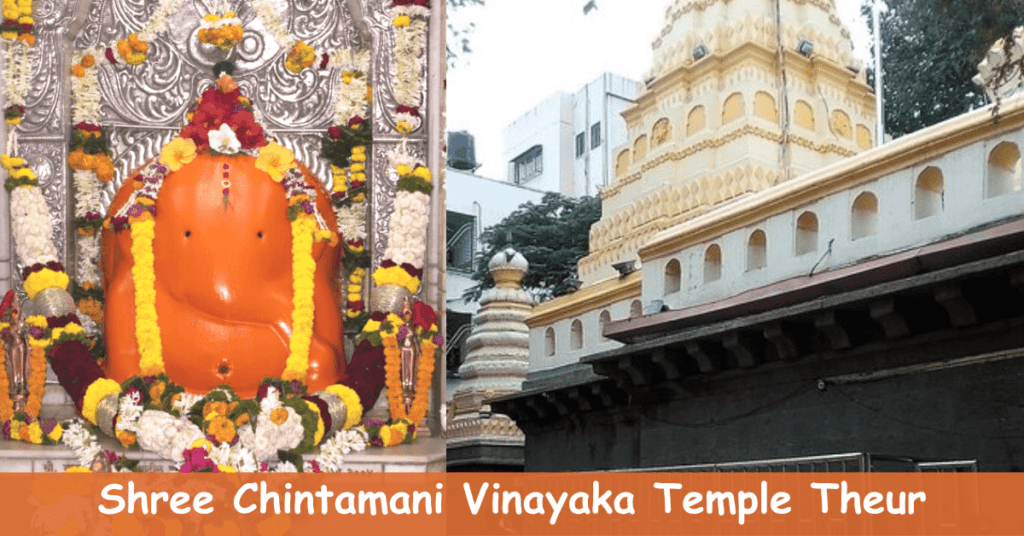Introduction-Welcome to the enchanting world of Shree Chintamani Vinayaka Temple Theur, a divine sanctuary nestled amidst the tranquil landscapes of Maharashtra, India. This sacred temple holds a profound significance in Hindu mythology and is a beacon of spirituality and devotion for countless devotees seeking solace, blessings, and enlightenment.
Shree Chintamani Vinayaka Temple Theur, also known as Siddhatek Ganpati Temple, is one of the eight Ashtavinayak temples dedicated to Lord Ganesha. It’s situated along the banks of the Bhima River and is thought to be built during the Peshwa dynasty’s rule. It is surrounded by greenery and stunning natural beauty.

Stepping into the premises of Shree Chintamani Vinayaka Temple Theur is akin to entering a realm of divinity and tranquility. Legend has it that the temple holds a special significance as Lord Ganesha, in the form of Chintamani, is believed to have fulfilled his devotees’ wishes and bestowed wisdom and prosperity upon them.
The Divine Timeline: Tracing the History of Shree Chintamani Vinayaka Temple Theur
The history of Shree Chintamani Vinayaka Temple Theur spans centuries, is rooted in mythology, and is intertwined with the rich cultural heritage of Maharashtra. This sacred temple holds an important place among the Ashtavinayak temples, revered as an abode of Lord Ganesha and a source of spiritual solace for devotees.
Legends and ancient manuscripts place the temple’s beginnings during the time of the Mahabharata. It is believed that Lord Brahma himself installed the idol of Lord Ganesha, known as Chintamani, at this auspicious location. The temple’s name, “Chintamani,” signifies the ability of the deity to dispel worries and fulfill the desires of devotees.

According to historical accounts, Peshwa, a significant Maratha Empire king, oversaw the construction of the temples as we know them today. It is said to have been built in the 18th century under Madhavrao Peshwa’s patronage, the Empire’s fourth Peshwa.
The intricate carvings on the temple walls, the magnificent pillars, and the sanctum’s ornate design reflect the artistic prowess of the artisans of that era.
The great Saint Samart Ramdas, the spiritual guide of Chhatrapati Shivaji Maharaj, the founder of the Maratha Empire, paid a visit to the temple, which is one of its significant historical occurrences. Samarth Ramdas played a crucial role in popularizing the worship of Lord Ganesha in Maharashtra, and his association with the temple further elevated its significance.
Throughout history, the Shree Chintamani Vinayaka Temple Theur has witnessed countless pilgrims’ devotion, seeking blessings, guidance, and fulfillment of their desires.
The temple’s historical and cultural importance extends beyond its religious significance. It stands as a testimony to the vibrant cultural heritage of Maharashtra, reflecting the architectural style prevalent during the Peshwa era. It is also a reminder of deep-rooted faith and devotion passed down through generations.
Today, Shree Chintamani Vinayaka Temple Theur thrives as a revered pilgrimage site, attracting devotees from near and far. The temple’s historical heritage and spiritual atmosphere make it a prized destination for those seeking a connection with the divine and a glimpse into the rich heritage of Maharashtra cultural heritage.
As devotees flock to this sacred abode, the history of Shree Chintamani Vinayaka Temple Theur lives on, preserving the traditions, stories, and spiritual significance associated with this divine sanctuary.
What is the meaning of Chintamani Ganesha?
Well, find out the real meaning of “Chintamani Ganesha.”
Chintamani: In Hindu mythology, “Chintamani” refers to a wish-fulfilling gem or a magical jewel. It is believed to possess the power to grant the desires and dispel the worries of those who have it. ‘Chintamani’ is derived from two Sanskrit words, ‘Cinta’ meaning concern or interest and ‘Mani’ meaning gem or jewel. Therefore, Chintamani represents a gem of immense value and significance that brings peace, prosperity, and fulfillment of wishes.

Ganesha: Ganesha, commonly called Ganapati, is highly respected in Hinduism and widely adored as the god of wisdom, intellect, and fresh starts who removes obstacles. He is depicted with an elephant head and a human body, symbolizing intelligence, power, and auspiciousness. Ganesha is a major among the adored and beloved gods in the Hindu pantheon.
So, when we refer to “Chintamani Ganesha,” we are essentially invoking the divine form of Lord Ganesha, who is believed to possess the attributes of the wish-fulfilling gem. It symbolizes the aspect of Lord Ganesha that grants the devotees their wishes, alleviates their worries, and brings blessings of prosperity and fulfillment into their lives.
Why is Chintamani Ganpati so famous?
Chintamani Ganpati is famous for several reasons, rooted in its historical significance, religious associations, and the devotion of countless devotees. Here are some factors that contribute to its fame:
Wish Fulfillment: Chintamani Ganpati is renowned for being a wish-fulfilling deity. Devotees believe praying to Chintamani Ganpati can grant their desires, bring prosperity, and dispel worries. The temple has countless stories and testimonials from devotees who claim their wishes were fulfilled after seeking the blessings of Chintamani Ganpati.
Historical Importance: The Chintamani Ganpati Temple holds a deep historical significance. It is one of the eight Ashtavinayak temples dedicated to Lord Ganesha, considered highly sacred in Hinduism. The temple’s origin dates back centuries and is associated with mythology and legends, adding to its historical allure.
Spiritual Significance: Lord Ganesha is widely revered as the remover of obstacles and the god of wisdom and intellect. As a form of Lord Ganesha, Chintamani Ganpati is believed to possess unique powers and blessings. Devotees flock to the temple seeking spiritual guidance, seeking solutions to their problems, and finding strength and inspiration.
Cultural and Artistic Splendor: The Chintamani Ganpati Temple showcases magnificent architecture and intricate artwork. The visitors are captivated by the spectacular temple’s monumental sculptures, imposing pillars, and lavish interiors. The temple is a testament to the region’s artistic prowess and cultural heritage.
Pilgrimage Destination: Chintamani Ganpati Temple is a popular destination for devotees across India and beyond. Its fame has spread far and wide, drawing both locals and tourists who wish to experience the spiritual energy and seek the blessings of Chintamani Ganpati.
Devotee Experiences: Numerous devotees have shared their personal experiences of the miracles and blessings they have received at Chintamani Ganpati Temple. These stories have further enhanced its reputation and made it a sought-after destination for those seeking divine intervention and solace.
The combination of these factors contributes to the fame of Chintamani Ganpati. Its reputation as a wish-fulfilling deity, historical importance, spiritual significance, cultural splendor, and the devotion of countless devotees have elevated its status as a renowned and revered place of worship.
Who established Chintamani Ganpati?
The detailed historical records of who established Chintamani Ganpati Temple (also known as Chintamani Vinayaka Temple) are not widely documented. However, according to local myths and traditions, the temple was built under the Peshwas’ rule, a powerful family who ruled the Maratha Empire in the 18th century.
It is believed that Madhavrao Peshwa, the fourth Peshwa of the Maratha Empire, played a significant role in the construction and establishment of the Chintamani Ganpati Temple. The temple is said to have been built under his patronage and supervision, showcasing that era’s architectural and cultural brilliance.
While historical records may not provide explicit details about the temple’s establishment, the association with the Peshwa dynasty has contributed to the temple’s historical significance and its connection to the rich cultural heritage of Maharashtra. The devotion and patronage of the Peshwas have played a crucial role in shaping the temple’s prominence and popularity among devotees.
What is the story of Chintamani Ganpati Theur?
The story of Chintamani Ganpati at Theur is rooted in Hindu mythology and legends. According to the ancient texts and folklore, the story revolves around a celestial jewel known as the Chintamani gem and its association with Lord Ganesha.
Once, Lord Indra, the king of gods, possessed a celestial jewel called Chintamani, which could fulfill any desire and grant immense wealth and prosperity. However, Indra became arrogant and started misusing the gem, causing chaos and imbalance in the universe.
To restore order, Lord Vishnu, the preserver of the universe, took the form of a Brahmin and approached Indra, requesting him to surrender the Chintamani gem. Indra realized his mistake and willingly handed over the rock to Lord Vishnu.
Lord Vishnu entrusted the gem to his consort, Goddess Lakshmi, who, in turn, placed it in her beloved son Lord Ganesha’s hands. Lord Ganesha accepted the responsibility of guarding the Chintamani gem and vowed to use its power to bless and help humanity.
It is believed that Lord Ganesha, in the form of Chintamani Ganpati, established his abode at Theur to protect the Chintamani gem and grant the desires of devotees. The Chintamani Ganpati Temple was built to house the divine idol of Lord Ganesha, holding the sacred Chintamani gem.
Devotees flock to the Chintamani Ganpati Temple at Theur to seek the blessings of Lord Ganesha and the wish-fulfilling powers associated with the Chintamani gem. It is believed that sincere prayers and devotion to Chintamani Ganpati can fulfill desires, remove worries, and maximize prosperity and success.

The story of Chintamani Ganpati Theur serves as a reminder of the divine power of Lord Ganesha and the significance of seeking his blessings. It exemplifies the belief that Lord Ganesha, as Chintamani Ganpati, is ever-ready to protect and guide his devotees, providing solace and granting their wishes.
Conclusion
In conclusion, the Shree Chintamani Vinayaka Temple in Theur is a magnificent testament to India’s rich cultural and spiritual heritage. The temple has a particular place in the hearts of millions of believers due to its historical significance, architectural splendor, and sincere adoration.
The temple has endured the ups and downs of time throughout its lengthy and illustrious history while maintaining faithful in its dedication to promoting spiritual development and offering consolation to those in need. The graceful presence of Lord Ganesha, embodied by the magnificent idol of Chintamani Vinayaka, is believed to bring blessings, prosperity, and wisdom to all who visit. Theur and its cherished temple have the power to touch the hearts and souls of all who enter, leaving an indelible mark on their spiritual journey.
